 |
surfresearch.com.au
surfers
: george downing
|
George Downing
| home | catalogue | history | references | appendix |
 |
surfresearch.com.au
surfers
: george downing
|
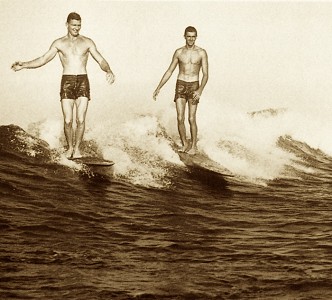 |
Wally Froiseth (left) and George Downing, Waikiki, 1949. Wally Froiseth gluing up a
laminated blank, Honolulu, late 1940s.
George Downing assisting. |
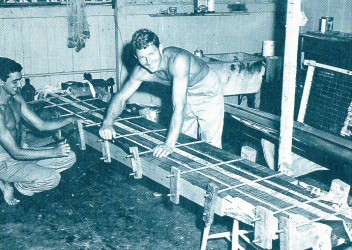 Photograph:
Wally Froiseth
Nat's History, page 67. |
| George
Downing's Rocket, 10ft x 20" - 1952. Laminated balsa wood blank with three redwood stringers, fibre-glassed, fin-box, fitted timber and fibre-glassed fin.   |
The Rocket's Fin-box, 1952. Photograph: Marshall
Crum
|
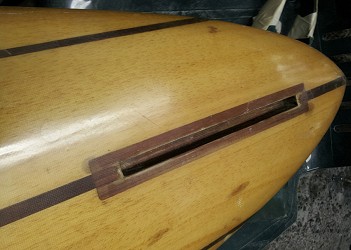 |
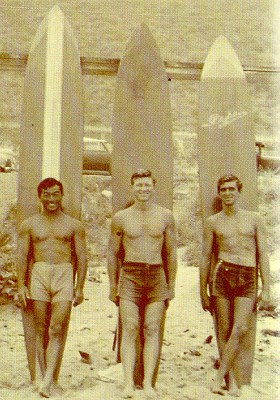 Ross Tanaki, Wally Froiseth, and George Downing, Hot Curls at Malibu, 1947. Nat's History, page18.
|
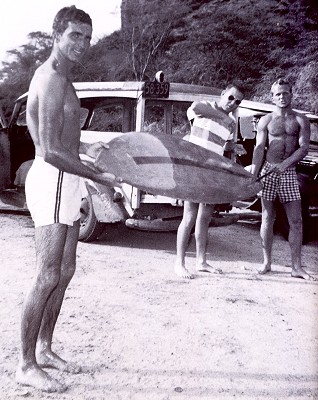 George Downing, Walter Hoffman and Buzzy Trent, Makaha, 1952. |
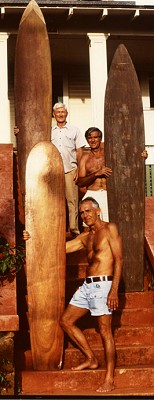 Wally Froiseth, John Kelly, and George Downing, 1989. |
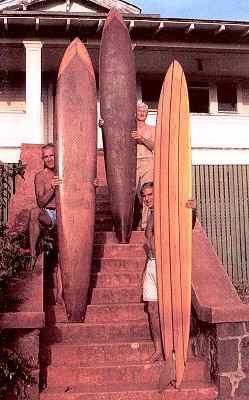 John Kelly,
Wally Froiseth, and George Downing, 1989. |
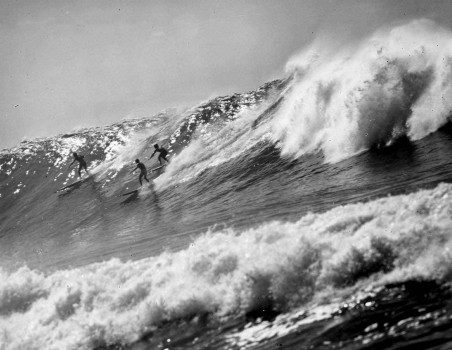 |
Woody Brown,
Buzzy Trent and George Downing, Makaha Point,
1953.
Photo by “Scoop” Tsuzuki. In a chapter titled Big Waves - Big Guns in his History of Surfing (1983), Nat Young credits the photograph as inspiring the now annual winter pilgrimage to the North Shore: About the winter of 1955 a San Francisco paper published a front page photograph of three surfers screaming across a giant Makaha Point wave; they were George Downing, Wally Froiseth and Woody Brown. That shot blew everyone away, all up and down the coast. Keen surfers had already seen Bud Browne's early surfing movies of big-wave riding in Hawaii, but seeing that shot in a mass-circulation paper made everyone realise what Hawaii could hold in store for them. After that every winter, about November, a crew of Californian surfers made the pilgrimage to Hawaii with the intention of riding waves at Sunset Beach and Makaha. Note the date as 1955, and Wally Froiseth instead of Buzzy Trent. Also note that the image is slightly misleading; in framing to the left, Tsuzuki has significantly enhanced the wave height. |
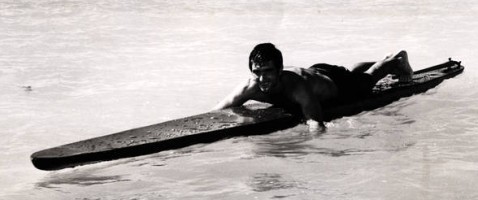 George Downing after winning
the 6-mile main event of the
Diamond Head Surf Board Paddling championship,1953. George
Downing, Makaha, 1954.
Surfer Magazine Archives. |
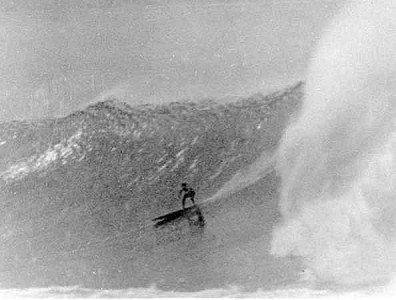 |
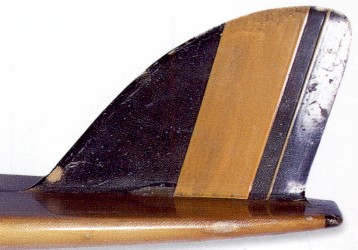 |
1960 Downing Gun Fin Wood and fibreglass 10 x 8 b @ 2 inches (approximation) George Downing Surfboards, Hawaii. Ed and Randi Economy Collection "...one of ten shaped by George Downing and was his personal board. Stripes on fin were used to identify boards that went out to sea as these were pre-leash days. This was a common occurrence at Sunset beach in the early 1960 's." Blackburn, page 73. |
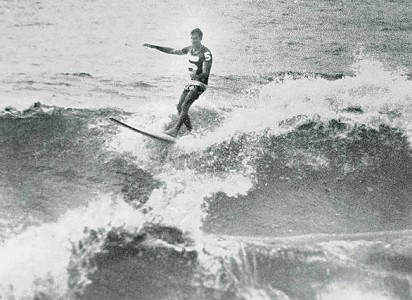 |
George
Downing, Makaha Contest, 1961.
Program:
Waikiki Surf Club Presents 9th Annual International Surfing Championships. Makaha Beach, January 6-7 and 13-14, 1962. The program included a map of Makaha Point on page 6, with the location of the judges stands and marker buoys, subject to surf conditions. It also included an advertisement for Hobie Surfboards with photographs of Hobie Alter and his agent in Honolulu, George Downing. |
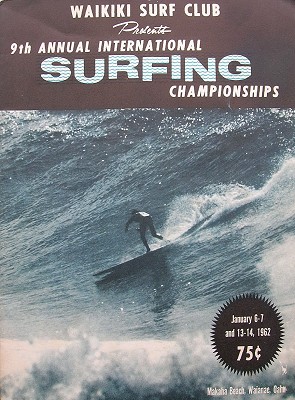 |
 Hobie Surfboards' agent in Honolulu, George Downing, Makaha, 1961. 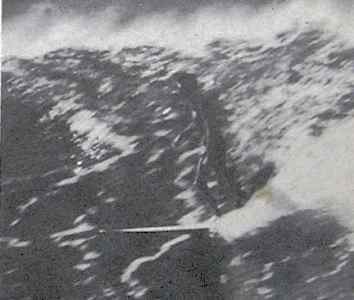 |
Design by International
Surfing Champion
George Downing 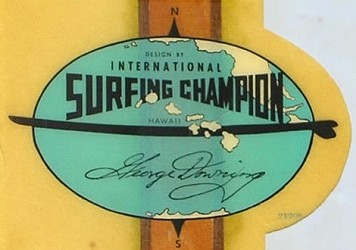 Decal:
1964 George Downing Champion – Delux Model 11′ 0″ Serial number 21708 2″ balsa redwood t-band stringer light blue pigment competition stripes rising sun multi-laminated wood fin. |
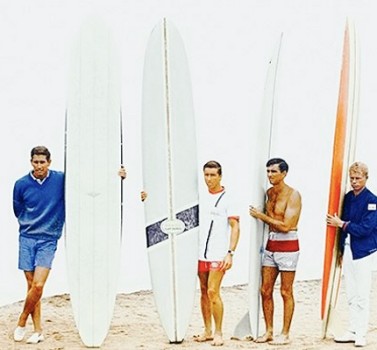
Semi-finalists: Joey,
Cabell, Felipe Pomar,
George Downing, Midget Farrelly. |
1965 World Contest, Peru.
Punta Rocas, 20-21 February. 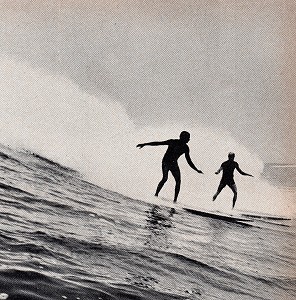 George Downing and Ken Adler, Punta Rocas, 1965. |
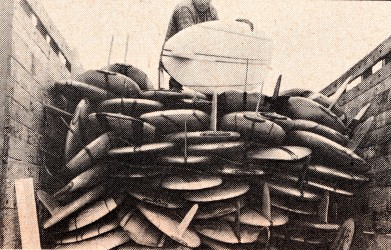 On the way from Lima to Punta Rocas, George's board is somewhere in the back of the truck. All photographs by John Severson
Surfer,Volume 6 Number 2, March 1965. Board portrait courtesy of Fred Hemmings. |
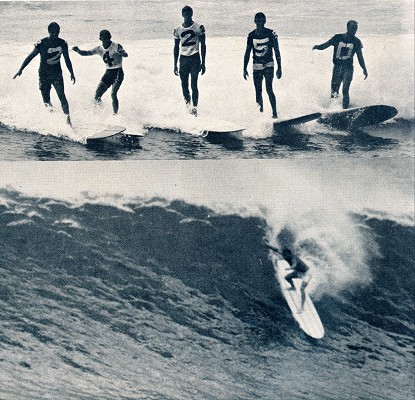 |
Makaha
Contest, 1965.
Photographs by Bill Cleary. ... this ripple
crowded with five surfers was typical of the waves
during
preliminaries of the Makaha International. That's George Downing, number 5, who picked up his third Makaha title. (George Downing, Makaha Final, 1965 ?) See: Duke and Makaha Contests, 1965. Surfer, Volume 7 Number 1, March 1966. |
Duke Kahanamoku with 1965 Duke Contest Invitees. Honolulu Star-Advertiser, 1965. Left to right: Felipe Pomar,
George Downing, Mike Doyle, and Fred Hemmings,
Jr.
|
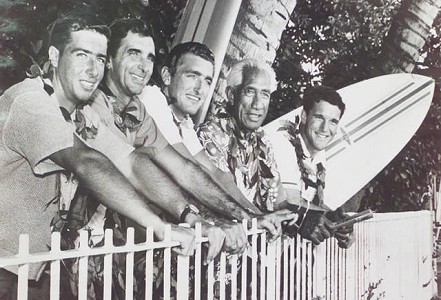 |
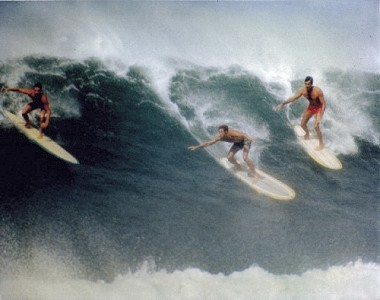 Joey Cabell and George Downing, Haleiwa,
1967.
Photo: Leroy Grannis. |
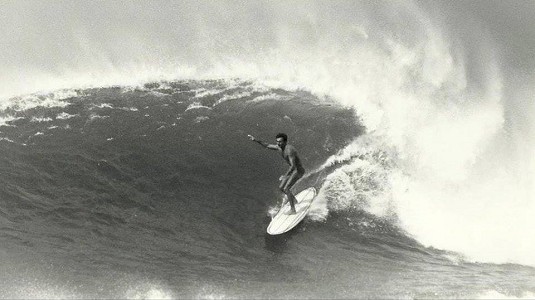 George Downing,
Sunset- Haleiwa (?), 1967.
|
 Wally
Froiseth,
John Kelly,
and George Downing, 1989.
|
 John Kelly,
Wally Froiseth, George Downing, 1989.
|
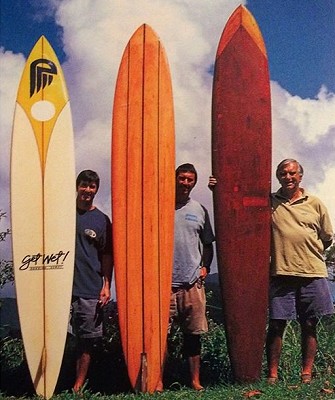 The Downings - Keone, Kainoa, & George, 2000. |
 |
Woody Brown, Buzzy
Trent and George Downing, Makaha Point, 1953. Photo by “Scoop” Tsuzuki. 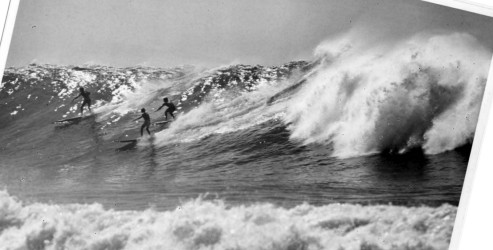 Rotated to the right, the line of white-water is now horizontal. |
| Objective Methods of Judging
Surfing. In the mid-1970s, George Downing was one of the innovators of the short-lived points-for-manoeuvre format (also known as the Hang Ten, or objective system) introduced at some contests on an emerging world circuit, later evolving into the International Surfing Professionals (IPS) under the direction of Fred Hemmings and Randy Rarick, 1976-1983. This was not the first attempt to quantify surfing performance; at Makaha in the late 1950s-early 1960s, length-of-ride was highly rewarded by the judges; each ride judged out of 30 points for distance and out of 10 points for performance. Commenting on the 1964 contest, Wally Froiseth explained stressing distance encouraged contestants to really turn on - ride the wave from outside, cut back from the outside buoy and hot-dog until they reach the inside turning buoy near the shore. Map of Makaha Point Contest Area. At the beginning of 1966, the Hawaiian Surfing Association contest rules allocated a pre-set point spread for Takeoff, Ride, Cutout, and Style; and later that year Tom Morey, as President of the USSA, proposed two alternate contest formats: Timed rules simply accumulated the time a competitor spent standing on the board. Paired eliminations matched just two surfers in the water one at a time. The Paired elimination format was resurrected by Peter Drouyn as the Man-on-Man system for the first Stubbies Contest at Burleigh Heads in March 1977, won by Michael Peterson. Under George Downing's objective system each manoeuvre was allocated a specific score, which increased with a larger wave height, in four sizes, tube rides scored on wave height and time in seconds. In a hang-over from the 1965, points were allocated for a hang-five, hang-ten, and a stretch-five, also calculated on wave height and time in seconds. As surfboards had radically shrunk in length and volume since 1967, by the 1970s nose riding had all but disappeared from progressive surfing. Similarly, points were also awarded for a side-slip (deliberating disengaging the fin from the wave face) and the associated helicopter-360; the technique was popular for a brief period in 1969, although judges at the 1970 World Contest were directed not to score such manoeuvres. Interestingly, the technique returned to progressive surfing at the end of the 20th century, initially employed in the recovery after surfers had left the wave face and taken to the air. The objective system was only used at two Hawaiian contests, under George's direction, but was used more widely in Australia; first trialled at the 1973 Rip Curl Easter Bells Beach Contest. The contest was won by Michael Petersen; junior competitor Mark Richards recalling that MP had a copy of the official points system taped to the dashboard in his car. It was used again at the next Bells Contest, the 1974 Coke 2SM Surfabout, and the 1975 Bells, and all won by Petersen. The system was widely criticised, notably by World Champions Nat Young and Fred Hemmings, and it had disappeared by the end of the 1970s. Points
Allocation for the Bells Beach Contest, Easter 1975.
However, twenty years later another attempt was made
to quantify surfing performance with the K2 Big
Wave Challenge.
Held over twelve months, 1997-1998, competitors submitted photographs for the judges, professional surf photography experts and experienced big wave surfers, to measure the tallest waves in the objective categories. First place in the K2, and $50,000, was awarded to Taylor Knox for riding a 52ft wave at Todos Santos. This was followed by the XXL Big Wave Awards, the contest period March to March, now under the banner of the World Surf League Big Wave Award. The first XXL Biggest Wave Award (2000-2001) went to Mike Parsons, who towed into a wave at Cortes Bank measured at 66 feet on the face. The following year a Big Wave Paddle Award was instituted (as distinct from tow-in), won by Paul “Antman” Paterson at Waimea Bay. In 2011-2012, Garrett McNamara towed into a 78ft wave at Nazaré, Portugal. The Big Wave Awards have grown to include seven categories. Many thanks to Fred Hemmings and
Garry Lynch for their contributions and assistance.
|
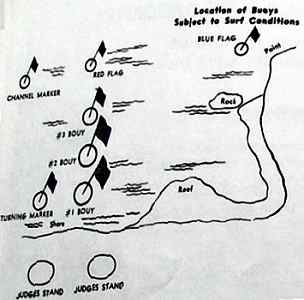 Waikiki Surf Club: 9th Annual International Surfing Championships Makaha Beach,1962, page 6. 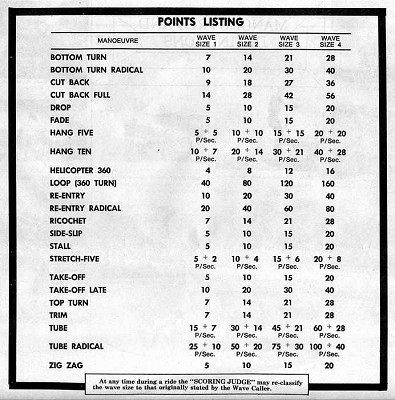 Tracks #53
February 1975.
|

| home | catalogue | history | references | appendix |